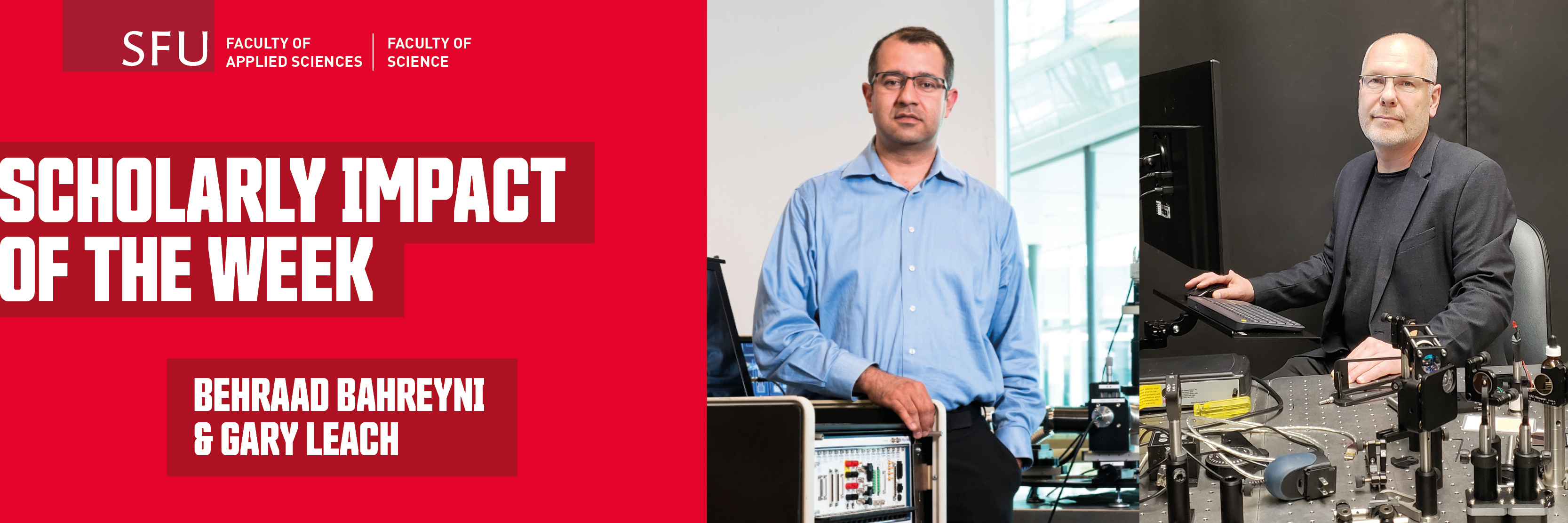
Behraad Bahreyni is an associate professor at Simon Fraser University's (SFU) School of Mechatronic Systems Engineering, and the founder and director of the Intelligent Sensing Laboratory. His research focusses on how miniaturized devices and structures—known as microsystems—can improve functionality, performance and safety in a number of applications.
Gary Leach is an associate professor in the Department of Chemistry and director of photonic systems at the SFU core facility 4D LABS. His research program is advancing knowledge of the physical and chemical nature of surfaces and interfaces by examining their structure, dynamics and reactivity.
Together Bahreyni and Leach are developing new and useful technologies, materials and processes. Their interdisciplinary collaboration had led to the creation of a micromachined vector light sensor that can detect both the intensity and direction of light from a source—the first-of-its-kind to do so. This novel vector light sensor can have numerous applications where a light sensor—or a group of them as an image sensor—can process light coming from different directions.
There are many notable features of the new device. Its innovative pyramid shape helps triangulate light intensity and distance, unlike typical sensors which only track light. It responds to infrared light emitted by humans and animals so it can be used to improve human safety for example, on heavy machinery and in factories. As a miniaturized sensor, it can work in smaller devices such as consumer electronics and it is energy efficient. And, because it is able to capture both light direction and intensity, it can map a three-dimensional (3D) image, opening the potential for use in virtual and augmented reality applications.
We spoke with Bahreyni and Leach about their work.
One of the most exciting aspects of the device is that it can be used to capture 3D images. How does it do this?
Typical light sensors are made of flat pieces of light-sensing regions that report the total light intensity falling onto them. Thanks to its 3D structure, each one of our sensors has a direction-dependent response, allowing us to determine the direction of an incoming beam of light. We demonstrated that a pair of these sensors might be used to estimate the distance to a light source with high accuracy. Further development should pave the way for using an array of these devices to create information beyond a simple image that is a light-intensity map of the scene. An example would be mapping the distance to different objects in the field of view.
How does the pyramid shape aid in the functionality of the device?
The pyramid shape is the differentiating factor between the operation of this sensor and others. Using microfabrication technologies we made each of the pyramid sidewalls sensitive to light, enabling us to compare the light intensity on those faces and then figure out the direction of the beam. Mathematically, this is quite simple—however, the breakthrough here was developing the technologies to realize the 3D structure of the sensor.
How does knowledge of chemistry factor into the development of these devices?
The device function was made possible through a combination of known chemical interactions between silicon (the structural material of the sensor) and various etching solutions. Beyond these foundational processes, we collaborated on developing new methods to develop sensors for infrared light detection specifically. Detecting infrared light (IR) was critical in our work as the project objective was to detect and track humans as IR (i.e., heat) sources near robots on a factory floor to improve safety. However, silicon cannot be used for IR detection and we needed to find methods for depositing suitable materials on top of the silicon microstructures. This necessitated a deep knowledge of chemical process development and characterization, which engineers do not have.
How did you happen to come together as collaborators and how important has interdisciplinary research been to your areas of expertise?
We learned about each other's work through different projects that our teams had at our shared facility (4D LABS). Once there was a need to utilize expertise from technical and scientific sides (i.e., engineering to design devices and make systems, and chemistry to study the material-level research), the rest followed. Without the collaborations, the project would have been impossible to finish. The interdisciplinary research also benefited our students by providing a rich training environment and exposing them to different areas of research, from material studies to device design and system development as well as detailed characterization methods along the way.
Read more about Behraad Bahreyni’s research on microsensors here.
Visit Gary Leach's Laboratory for Advanced Spectroscopy and Imaging Research (LASIR).
Learn more about the work of SFU’s 4D LABS at www.4dlabs.ca.
SFU's Scholarly Impact of the Week series does not reflect the opinions or viewpoints of the university, but those of the scholars. The timing of articles in the series is chosen weeks or months in advance, based on a published set of criteria. Any correspondence with university or world events at the time of publication is purely coincidental.
For more information, please see SFU's Code of Faculty Ethics and Responsibilities and the statement on academic freedom.